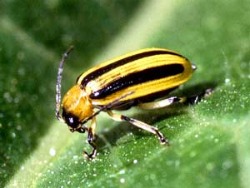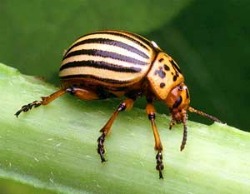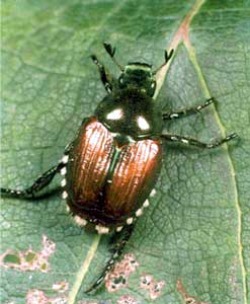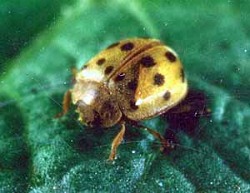
Cucumber beetles love to attack not only cucumbers, but melons and squash as well. Start your controls early, as soon as plants emerge, to thwart this pest.

Colorado potato beetles can decimate potatoes and eggplants. Squish eggs and spray B.t. 'San Diego' to control the larvae.
These are a different "Fab Four" than the ones I grew up with. Unlike the blokes from Liverpool, we don't welcome a site of these beetles in our yard. Beetles are some of the most difficult insects to control organically in the garden. Their hard shells protect them from sprays and they're mobile so can fly around feeding on a variety of plants.
Of all the pests in the vegetable garden, beetles require you to know something about their life cycle. The adult stage that we are all familiar with is often not the stage that is easiest to control. With a little planning, you can control cucumber, potato, bean, and Japanese beetles before they become major pests in your garden.
Before I get started talking about each individual pest, let me mention a few cultural practices that should always be used when trying to reduce pest populations in your garden. Rotate crops by not planting the same member of that crop family in the same location for three years. Plant insect-resistant varieties whenever possible, such as 'King Harry' potato for the potato beetle. Plant a diversity of crops including flowers, herbs, and berries to attract beneficial insects and animals that might help with pest insect control. Keep plants growing strong and healthy by feeding the soil, keeping weeds at a minimum, and watering well. Now on to the Fab Four. My apologies to the original Beatles if my analogies are a bit far-fetched.
Cucumber BeetleMeet the Ringo Starr of the beetle world. Like Ringo, cucumber beetles have wide ranging tastes and are difficult to corral using conventional methods. Unlike Ringo, cucumber beetles also can spread deadly diseases, such as bacterial wilt, with their feeding.
Cucumber beetles are either striped or spotted with yellow and black. They emerge in spring, having overwintered on plant debris in the soil. They feed on weeds until their favored plants, cucumber, melons, and squashes, start growing. The adults feed on new leaves and females lay eggs in the soil close to the plant. These eggs hatch into larvae that feed on the roots. They pupate in the soil and emerge as adults again for a second generation, depending on where you live. Their feeding not only damages leaves, stems, and flowers, but can spread bacterial wilt disease. This clogs up the vascular system of cucurbits, causing the plants to suddenly wilt and die.
To control cucumber beetles you have to be ready for them in spring. Hang yellow sticky traps above the plants. Cucumber beetles are attracted to the color yellow and will land on the trap, get stuck, and die. Cover the planting with floating row covers to block their entrance. Consider planting a trap crop of squash on the perimeter of the garden to lure the beetles away from your primary crop. If you must spray, try pyrethrum-based sprays in the evening when bees aren't flying to avoid harming them. To avoid the bacterial wilt disease grow varieties, such as 'County Fair', that are tolerant of the disease.
Colorado Potato Beetle
Japanese beetles not only love vegetables, but flowers, trees, vines and a whole host of plants. Control the larval forms of these beetles with sprays of milky spore powder and beneficial nematodes.

Mexican bean beetles love just beans. What they lack in variety, they make up for in appetite. Watch for these ladybug-like beetles on all bean plants.
Meet the George Harrison of the beetle world. Like George, Colorado potato beetles have a certain area of the world they're most comfortable with (the Southwest and east of the Rocky Mountains for the bug, England and India for George), but are universal now and have transformed themselves as they aged. The Colorado potato beetle starts out as masses of orange eggs laid by the adult beetle on the underside of potato, eggplant, pepper, or even tomato plants. The eggs hatch and turn into black and red, soft-bodied larvae that love to feed on the foliage. They can quickly decimate a plant. The adult yellow and brown striped beetle lays more eggs and keeps the cycle going for 2 to 3 generations, depending on where you live.
To control the Colorado potato beetle, be vigilant. Identify the adult beetle in early summer and then watch for clusters of orange eggs on the underside of leaves. Crush them and you'll reduce the population. Spray the black and red larvae with Bacillus thuriengensis 'San Diego'. This form of Bt is safe for all other insects, but kills the potato beetle larvae quickly. Handpick the adults and drop them into a pail of soapy water. Grow the new potato variety, 'King Harry',which has fuzzy leaves that supposedly the beetles don't like.
Japanese BeetlesMeet the John Lennon of the beetle world. The Japanese connection is obvious, but also like John, Japanese beetles are all about hanging out in groups. Unlike John, they don't want to give peas a chance.
Japanese beetles overwinter as larvae in the deepest reaches of the soil. As the soil warms in spring they migrate to the surface and eventually by early summer (June or July), emerge as adults. They feed on a wide range of plants, such as roses, basil, peas, beans, grapes, and raspberries. Once a Japanese beetle finds a great place to feed, it attracts other beetles, so you get masses of them on your leaves. Their feeding can skeletonize a plant. They live to feed and mate. They lay eggs in summer in lawn areas around the plants they fed on. The eggs hatch and the larvae tunnel into the soil to over winter.
To control Japanese beetles, get them before they become adults. Spray beneficial nematodes or milky spore disease powder on the soil and lawn where they have been feeding. The nematodes and bacteria parasitize the larvae and kill them. Spray either product in late spring or early fall when larvae are in the upper reaches of the lawn. Water them in well. Control the metallic-colored adults by hand picking in the morning when they're sluggish, laying a trap under favored plants and shaking them. Watch how the beetles roll and drop into the tarp to be killed. Spray Neem oil to discourage their feeding.
Mexican Bean BeetlesMeet the Paul McCartney of the beetle world. Like Paul, Mexican bean beetles like to tour, and have migrated from a southern insect pest to one that's seen all around the country. Although the bean beetle may look like a ladybug, it's not that nice. The yellow beetle with 16 black spots is the size of a ladybug. It overwinters on plant debris in the soil and emerges in spring as the weather warms to lay clusters of yellow eggs on the undersides of the leaves of all type of bean plants. The larvae feed for weeks on the leaves, skeletonizing them. Eventually they pupate and turn into adults. There are one to three generations a year, depending on where you live.
To control the bean beetles, crush the masses of eggs on the leaves in early summer. Handpick adults as you see them. Plant early-maturing varieties of beans that will be picked before the beetles become a big problem in mid- to-late summer. Spray insecticidal soap, neem oil, and kaolin clay to discourage this pest. You can also release Pedio wasps to parasitize the beetles.
More articles on controlling beetles in the garden:Colorado Potato Beetle
Cucumber Beetle
Japanese Beetle
Mexican Bean Beetle
 Charlie Nardozzi is an award winning, nationally recognized garden writer, speaker, radio, and television personality. He has worked for more than 30 years bringing expert gardening information to home gardeners through radio, television, talks, tours, on-line, and the printed page. Charlie delights in making gardening information simple, easy, fun and accessible to everyone. He's the author of 6 books, has three radio shows in New England and a TV show. He leads Garden Tours around the world and consults with organizations and companies about gardening programs. See more about him at Gardening With Charlie.
Charlie Nardozzi is an award winning, nationally recognized garden writer, speaker, radio, and television personality. He has worked for more than 30 years bringing expert gardening information to home gardeners through radio, television, talks, tours, on-line, and the printed page. Charlie delights in making gardening information simple, easy, fun and accessible to everyone. He's the author of 6 books, has three radio shows in New England and a TV show. He leads Garden Tours around the world and consults with organizations and companies about gardening programs. See more about him at Gardening With Charlie.
 Victory Seed Company has all the seeds you want for your best garden in 2024.
Victory Seed Company has all the seeds you want for your best garden in 2024.
For 25 years, the family-owned Victory Seed Company has provided the highest quality vegetable, herb and flower seeds to families across the country. We are passionate about providing you the best seeds available that give excellent germination, robust plants, and the harvest you want. With a catalog of over a thousand varieties, we have everything, and our prices are the kinds that we'd want to pay. We have hundreds of yesterday's heirloom vegetables, as well as today's award winning hybrid selections. Get to know us by visiting our website and browsing through our online vegetable seed catalog.